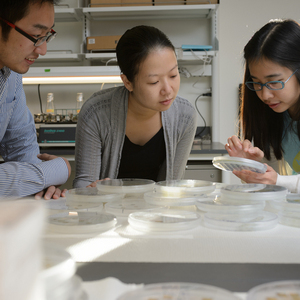Discovery of cellular snooze button advances biofuel research










G.L. Kohuth
October 16, 2014
BY Michigan State University
The discovery of a cellular snooze button has allowed a team of Michigan State University scientists to potentially improve biofuel production and offer insight on the early stages of cancer.
The discovery that the protein CHT7 is a likely repressor of cellular quiescence, or resting state, is published in the current issue of the Proceedings of the National Academy of Sciences. This cellular switch, which influences algae’s growth and oil production, also wields control of cellular growth – and tumor growth – in humans.
Christoph Benning, MSU professor of biochemistry and molecular biology, and his colleagues unearthed the protein’s potential while seeking ways to improve algae’s capacity as a biofuel. Its application in cancer research, however, was a surprise finding that is leading Benning’s lab in a new direction.
“Algae provide us with model organisms that rival, or possibly exceed, traditional yeast models,” Benning said. “It’s quite difficult to grow many types of human cells in test tubes. However, we can readily grow, manipulate and study algae, which have the genomic repertoire that make them relevant in their capacity to drive advances in human medicine.”
Advertisement
Advertisement
The discovery was made while tackling the conundrum of algae’s vexing inverse relationship with growing mass versus producing oil. When algae are awake, they grow; when they’re asleep, they produce oil.
“Producing oil is part of the cells’ survival strategy when it’s under stress,” said Chia-Hong Tsai, doctoral candidate with MSU’s Department of Energy Plant Research Laboratory and Department of Plant Biology and co-author. “They go into quiescence to conserve energy and nutrients. That’s when they produce the equivalent of vegetable oil. But to convert them into truly viable biofuel producers, we need them to grow and produce oil simultaneously.”
The secret for making this happen was CHT7 – the gatekeeper that cues cells to wake up or fall asleep. By engineering this protein, Benning’s team might one day develop an organism that can’t figure out how to doze and is always active. For biofuels, this would remove a major hurdle and gives scientists a way to potentially produce high amounts of oil and biomass.
Advertisement
Advertisement
In terms of human medicine, this discovery gives scientists a promising new model to study tumor suppression and growth. Because quiescent cells are found in many plants and animals, it’s a model that can provide important insights into the regulation of cellular behavior in organisms, such as us humans, in ways that traditional yeast models simply can’t replicate.
“For cancer research, it’s a new paradigm,” Benning said. “The switch that tells an organism to grow, or possibly, go rogue and grow uncontrollably – that’s exactly what we want to understand. That is the first step of tumor growth.”
Additional MSU team members included Jaruswan Warakanont, plant biology doctoral student; Tomomi Takeuchi, biochemistry and molecular biology doctoral student; Barbara Sears, professor emeritus of genetics and plant biology; and Eric Moellering, former doctoral candidate of biochemistry and molecular biology now at Synthetic Genomics Inc.
Related Stories
The U.S. Department of Energy Bioenergy Technologies Office (BETO) announced up to $23 million in funding to support research and development (R&D) of domestic chemicals and fuels from biomass and waste resources.
The U.S. DOE has announced its intent to issue funding to support high-impact research and development (R&D) projects in two priority areas: sustainable propane and renewable chemicals and algal system cultivation and preprocessing.
Sens. Sherrod Brown, D-Ohio, and Pete Ricketts, R-Neb., in August introduced the Renewable Chemicals Act, a bill that aims to create a tax credit to support the production of biobased chemicals.
The Chemical Catalysis for Bioenergy Consortium, a consortium of the U.S. DOE’s Bioenergy Technologies Office, has launched an effort that aims to gather community input on the development of new biomass processing facilities.
USDA on March 8 celebrated the second annual National Biobased Products Day, a celebration to raise public awareness of biobased products, their benefits and their contributions to the U.S. economy and rural communities.
Upcoming Events










